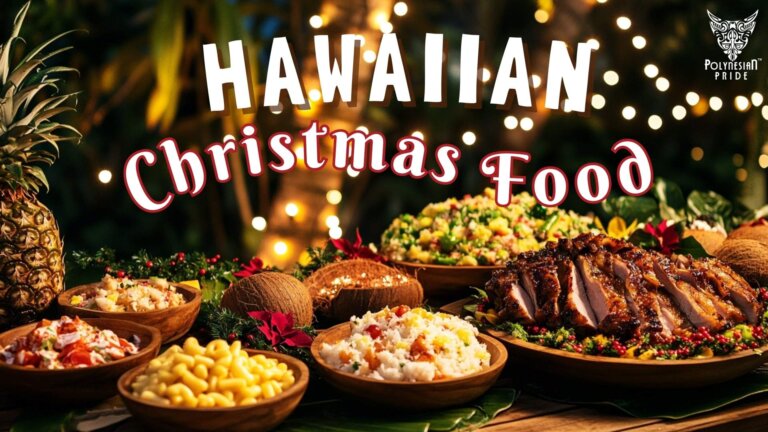What Is Barkcloth? Explore the Fabric That Connects Pacific Islands
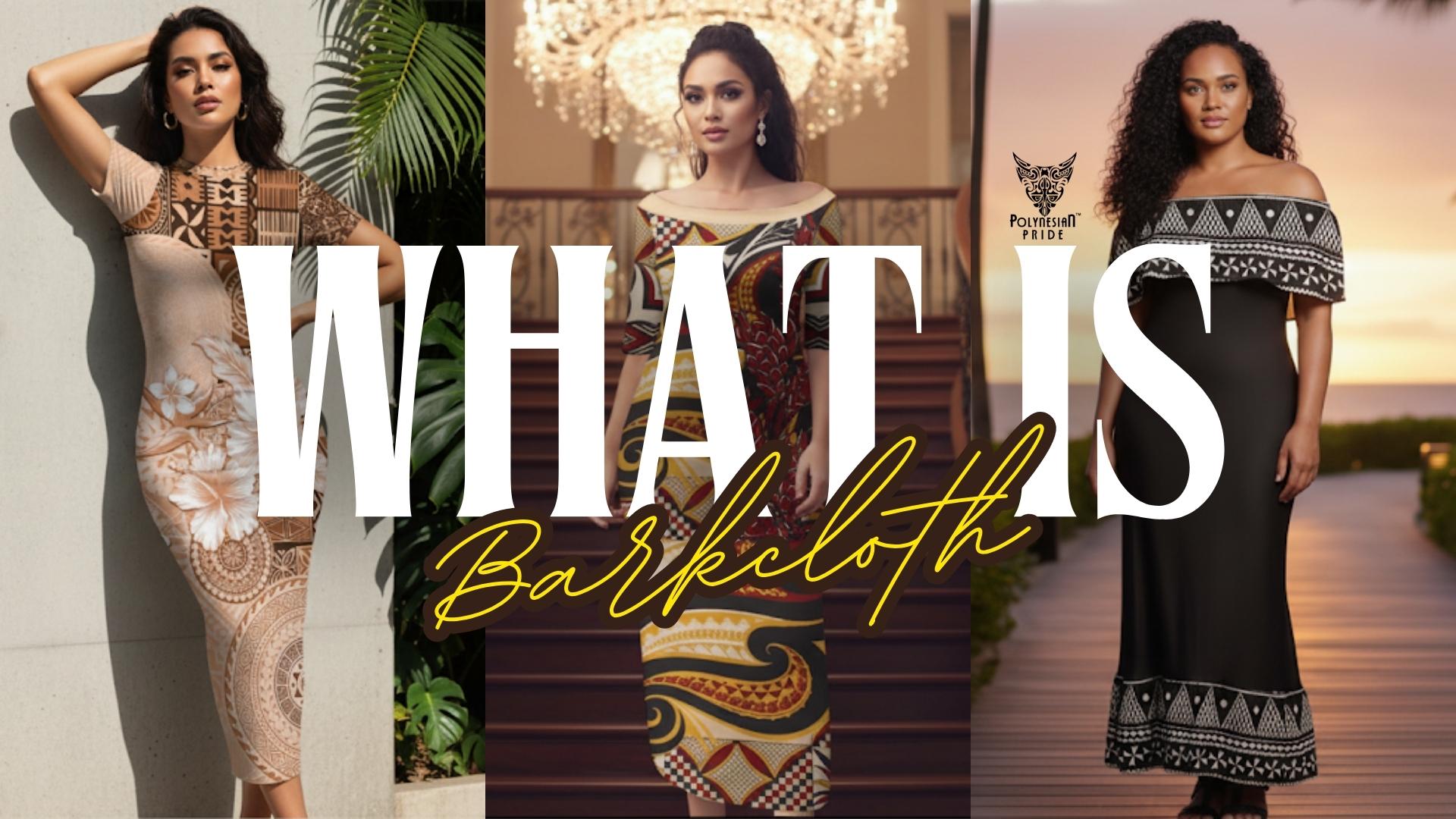
Let’s explore the most sacred fabric in the Pacific Islands!
Wondering what is barkcloth? From Hawaiian kapa to Tongan ngatu, it carries deep cultural meaning and heritage across the Pacific. Delve in with me and uncover its history, symbolism, and the artistry that keeps this tradition alive today.
What is Barkcloth Fabric?
Barkcloth fabric is unlike woven cotton or linen. It is a non-woven textile, made by pounding the fibrous inner bark of trees such as:
- Paper mulberry (Broussonetia papyrifera)
- Breadfruit (Artocarpus altilis)
- Ficus (fig trees)
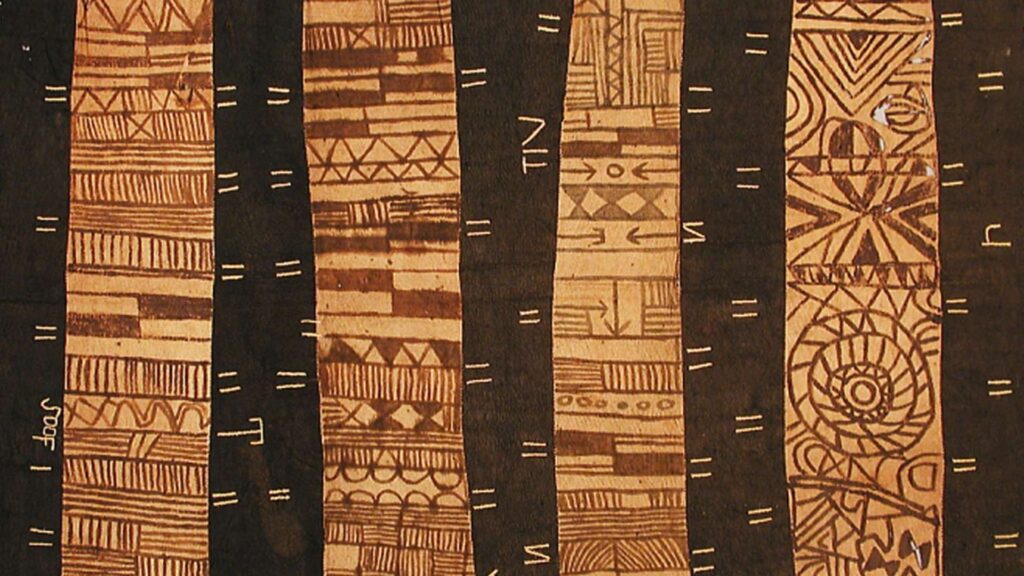
The process creates a soft yet sturdy fabric with a slightly rough texture. Depending on its preparation, barkcloth can range from thin and delicate to thick and durable.
Why Pacific Islands people love it:
- Natural look and texture, with each piece being unique.
- Durable and long-lasting when cared for properly.
- Holds dyes well, allowing for bold, symbolic designs.
This uniqueness made barkcloth essential in traditional life and modern décor and fashion.
The History of Barkcloth
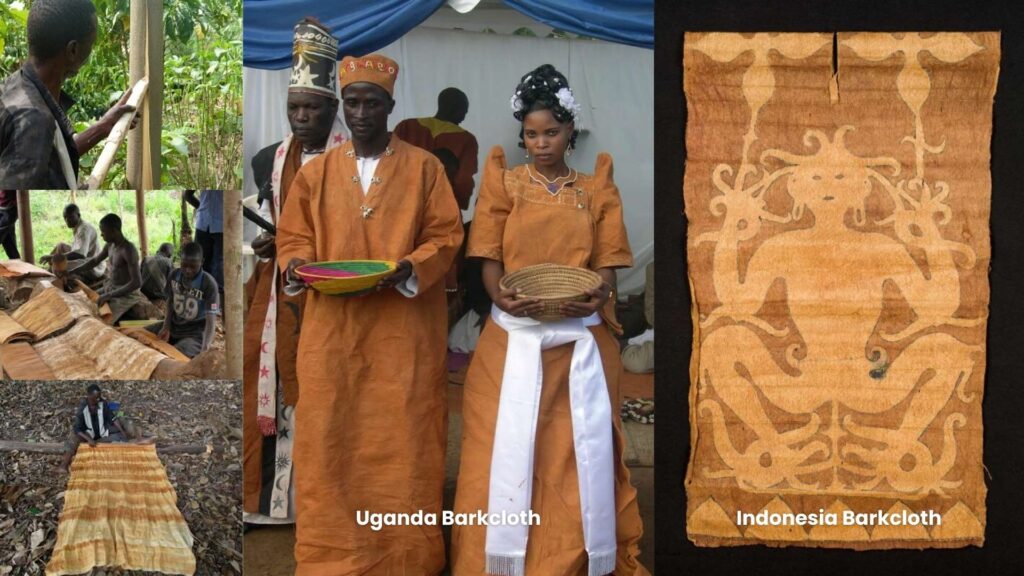
Barkcloth has deep roots worldwide. In Africa, it was worn by the Baganda people of Uganda. In Asia, it appeared in the Philippines and Indonesia.
But in the Pacific Islands, barkcloth became highly developed, both technically and artistically.
Historically, barkcloth was:
- Everyday clothing (skirts, loincloths, shawls, cloaks).
- Bedding and blankets.
- Ceremonial coverings in rituals and offerings.
- A way to show rank, wealth, or spiritual status.
Over time, Western textiles arrived and replaced barkcloth for daily use. Still, its cultural role remains strong, especially in Hawaii, Tonga, Samoa, and Fiji.
How Is Barkcloth Made?
Making barkcloth is the result of a careful, time-honored process. Each stage reflects both skilled craftsmanship and deep respect for nature. Below are the key steps in its traditional making:
Step 1: Harvesting the Bark
Makers cultivate paper mulberry and harvest when trunks/branches are optimal. In some Pacific areas, breadfruit or banyan/fig were also used, but Tonga and Sāmoa primarily relied on paper mulberry.
Harvesting follows cultural protocols of respect for land and resources.
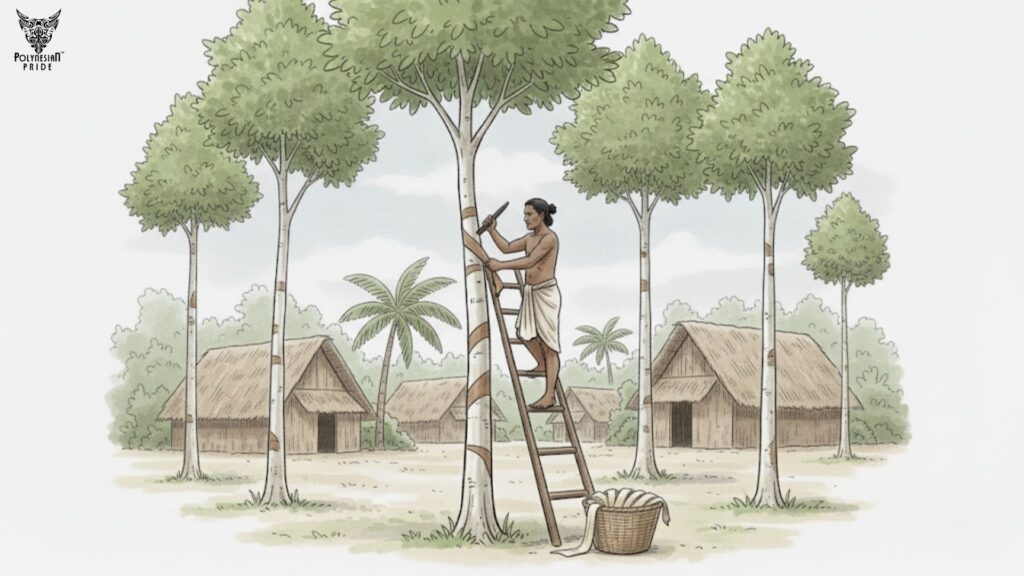
Step 2: Soaking and Fermentation
The outer bark is removed; inner bast strips are soaked, sometimes lightly fermented to soften fibres and aid felting during beating. This makes the bark pliable and workable.
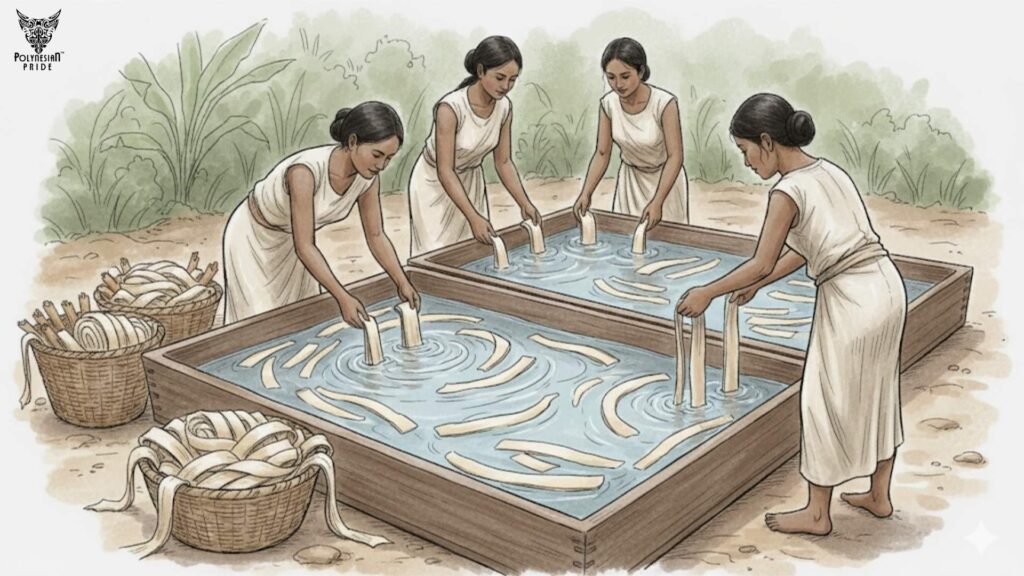
Step 3: Beating with Wooden Tools
Pounding gave barkcloth its form. Hawaiians used carved mallets (iʻe kuku) that spread fibers evenly and left textured patterns.
In Tonga, long wooden anvils allowed groups of women to work together. The pounding rhythm wasn’t noise but sounded like music. Villages heard the steady beat daily, a sound as central as church bells in Europe.
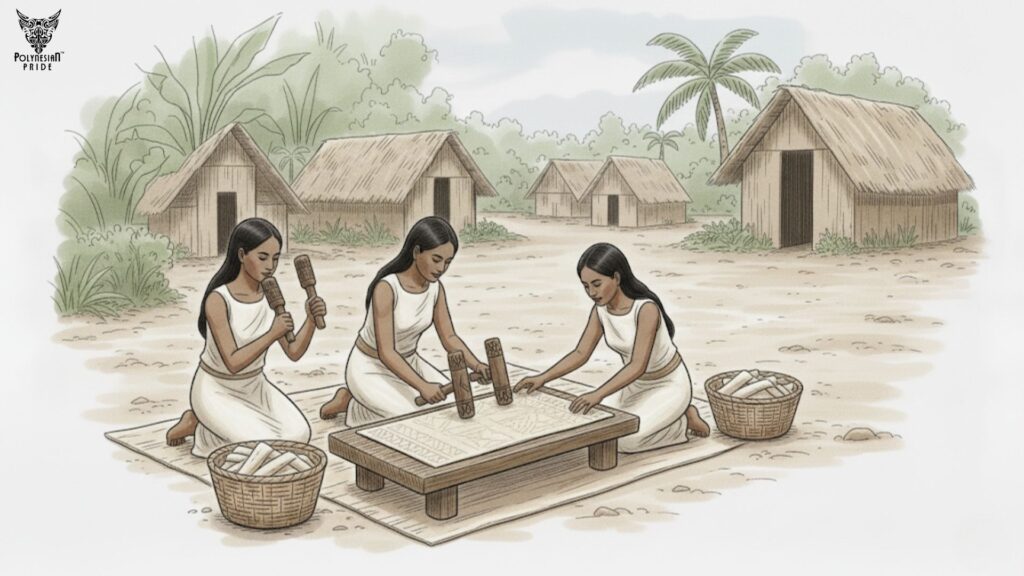
Step 4: Joining Sheets Together
Bark strips were too narrow for most uses, so women joined them into wide sheets:
- Edges overlapped and were pasted with starch from tapioca or arrowroot.
- Sheets could grow into giant rolls of ngatu in Tonga, sometimes longer than a house.
These rolls were stored, displayed at weddings or funerals, and valued as symbols of wealth and prestige.
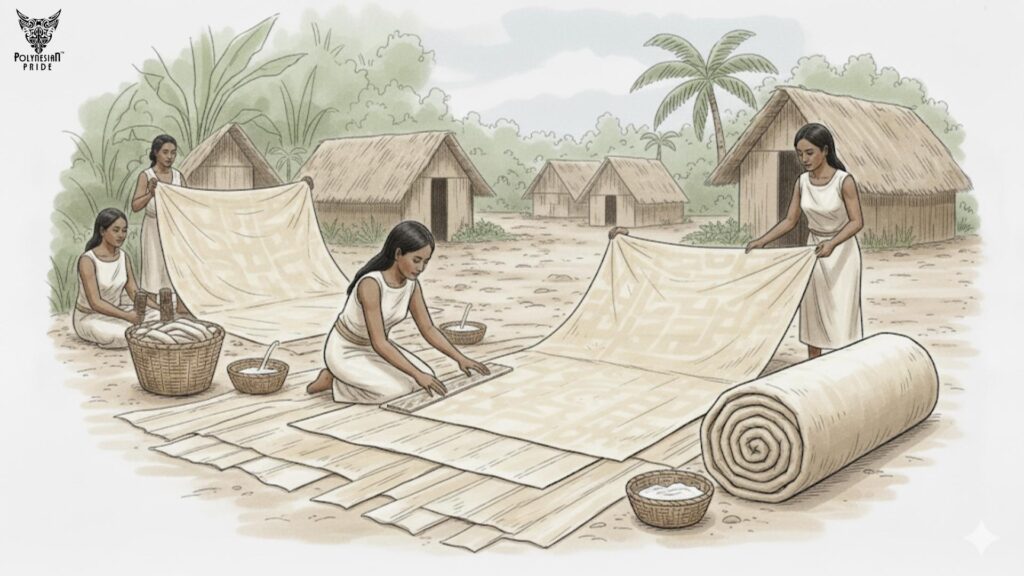
Step 5: Decorating the Cloth
Decoration transformed bark into art:
- Hawaiian kapa: stamped with bamboo (ohe kāpala).
- Samoan siapo: Freehand (siapo mamanu) and rubbing over ‘upeti boards (siapo ‘elei/tasina)
- Fijian masi: stencilled/rubbed motifs with black & brown on cream
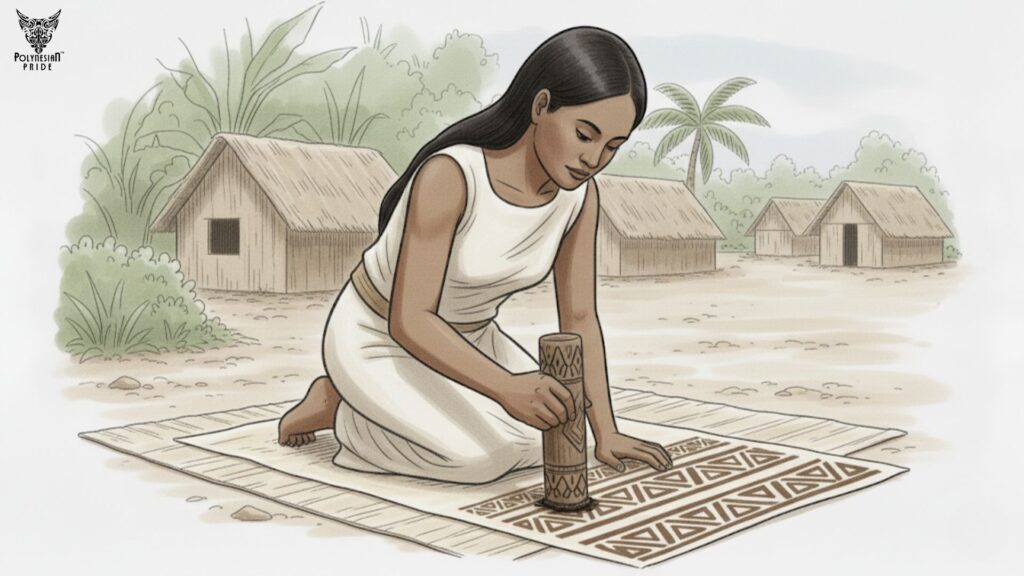
Dyes came from roots, berries, earth, and charcoal, each tied to the land. Designs told stories of family, nature, and spirituality. A decorated piece wasn’t just cloth; it was both heirloom and cultural passport.
Barkcloth in the Pacific Islands
While the basic process of making cloth from the inner bark of the paper mulberry is shared, each country in the Pacific Islands shaped it into unique forms, names, and meanings.
From the softness and stamped patterns of Hawaiian kapa to the bold rolls of Tongan ngatu, the painted siapo of Samoa, and the striking masi of Fiji, barkcloth remains a living expression of identity, artistry, and heritage.
Hawaiian Barkcloth (Kapa)
Softness & Craft
Hawaiian kapa was made from the inner bark of the wauke (paper mulberry) plant. Once beaten, the bark became soft and pliable, serving as clothing, bedding, and ceremonial cloth. Hawaiian Kapa plays a significant role in Hawaiian traditional clothing.
Patterns & Identity
Unlike the brilliant feather cloaks of the aliʻi (chiefs), kapa is recognized by its geometrically stamped patterns, featuring stripes, triangles, diamonds, and carefully arranged spaces of light and dark. These designs were the true visual signature of Hawaiian kapa.
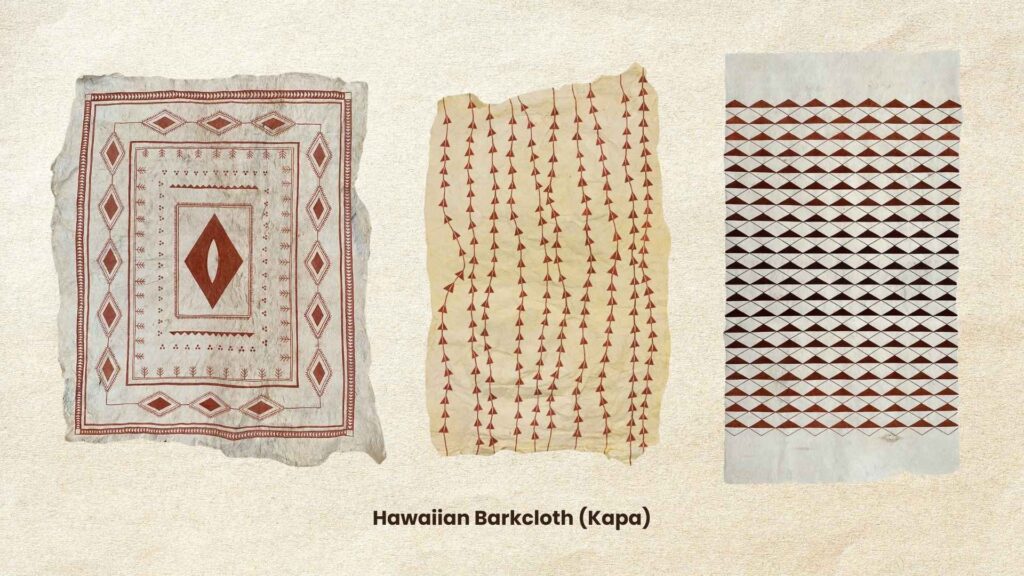
Natural Dyes & Colors
Ancient artisans drew color from everything nature offered—plants, berries, bark, soil, even sea creatures. Some traditional sources include:
- Kukui nut soot → black
- ‘Olena (turmeric root) → yellow
- ‘Uki‘uki berries → blue, gray, purple hues
- Maʻo (yellow hibiscus) → yellow-green
- Milo nuts → orange to reddish-orange
- ‘Alae (red earth) → reddish-brown
- Popolo berries & leaves → purple and green shades
- Java plum → pink to purple
- Butterfly pea blossoms → light to deep blue
- Hau flowers → multiple shades depending on stage of bloom
- Wana (sea urchin) → purples and dark black
🌿 Core principle: Mālama ‘āina, meaning care for and respect the land and its life.
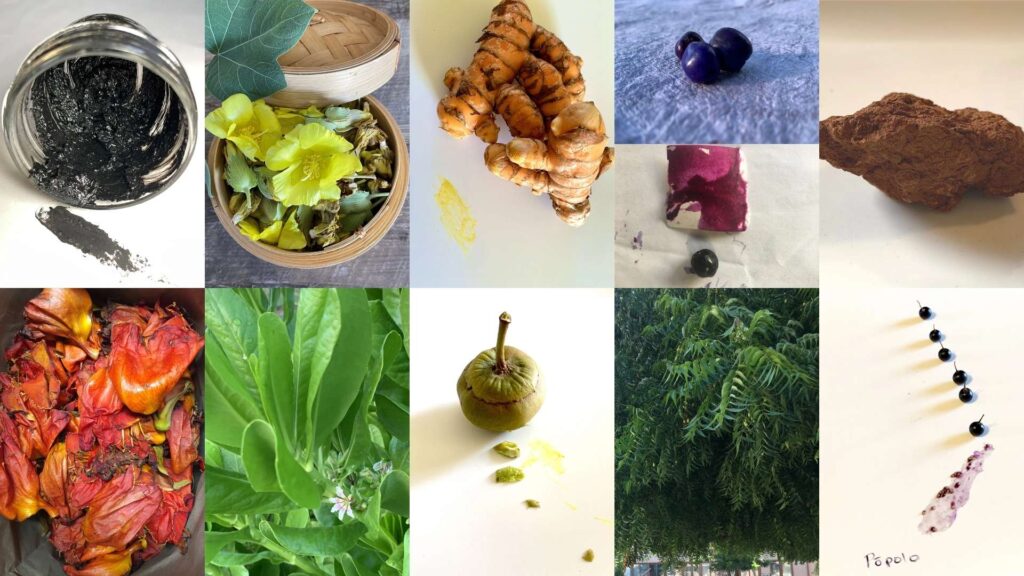
Cultural Role
- Every social class wore kapa, though the finest patterns and materials were reserved for the aliʻi.
- Priests used kapa in sacred rituals, often in plain white to symbolize divine purity.
- Women held the expertise of kapa-making. A skilled maker brought pride and prestige to her family.
Revival Today
Today, kapa is experiencing a revival. Hawaiian cultural practitioners are replanting wauke, rediscovering natural dyes, and teaching kapa-beating and stamping through workshops.
This living tradition continues to connect Hawaiians with their ancestors and land.
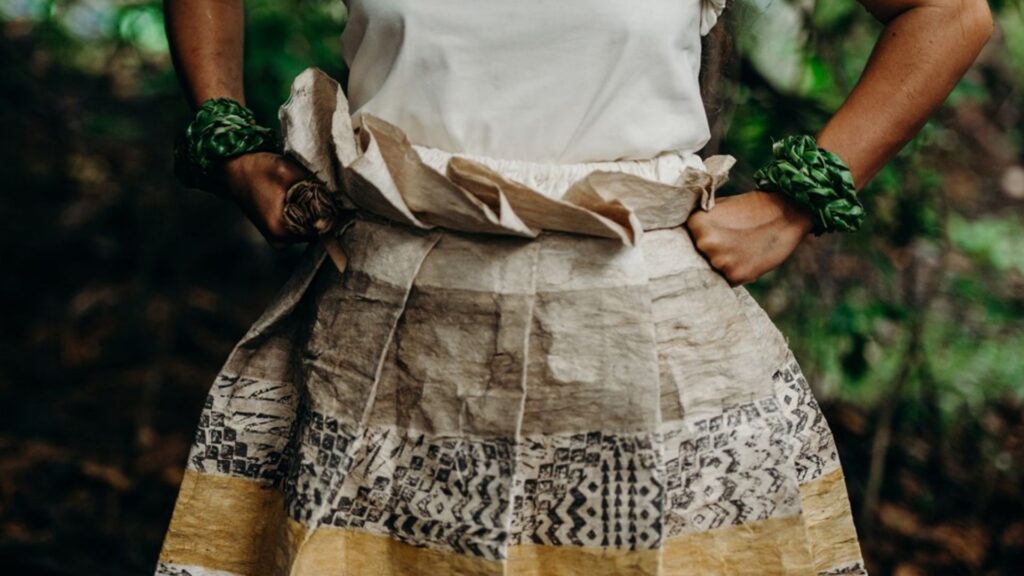
Tongan Barkcloth (Ngatu)
Materials & Process
Ngatu, aka Tonga’s version of barkcloth – also made from the inner bark of the paper mulberry (hiapo) is also plays a vital part in Tonga’s traditional clothing.
Tongan women gather in large community workshops called tutu‘a, where strips of bark are soaked, beaten into thin sheets, and joined together to form wide rolls.
Natural Dyes & Decoration
Ngatu is colored with earthy natural dyes:
- Koka (Bischofia javanica) → light brown
- Tongo (mangrove) → dark brown
- Special type: Ngatu ʻuli (black ngatu), reserved for funerals or chiefly use
Designs are applied using kupesi stencils made from coconut midribs or pandanus. Instead of stamping, women rub dye across the kupesi to reveal repeating geometric and symbolic motifs.
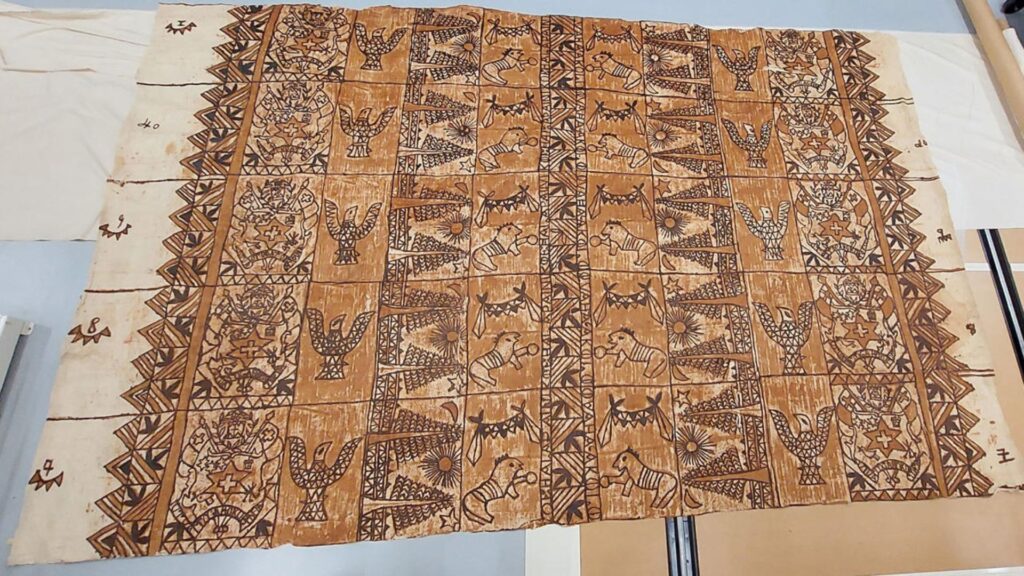
Patterns & Identity
Ngatu’s identity lies in its bold, repeated kupesi patterns:
- Geometric motifs (lines, chevrons, grids) form the structural base.
- Symbolic images may depict plants, animals, or even historic events. Some ngatu have recorded bicycles, ships, or power poles as marks of cultural memory.
- Large rolls are divided into segments called langanga, a Tongan unit of measurement unique to barkcloth.
This system of scale and repetition sets Tongan ngatu apart from Hawaiian kapa’s stamped minimalism and Samoan siapo’s painted motifs.
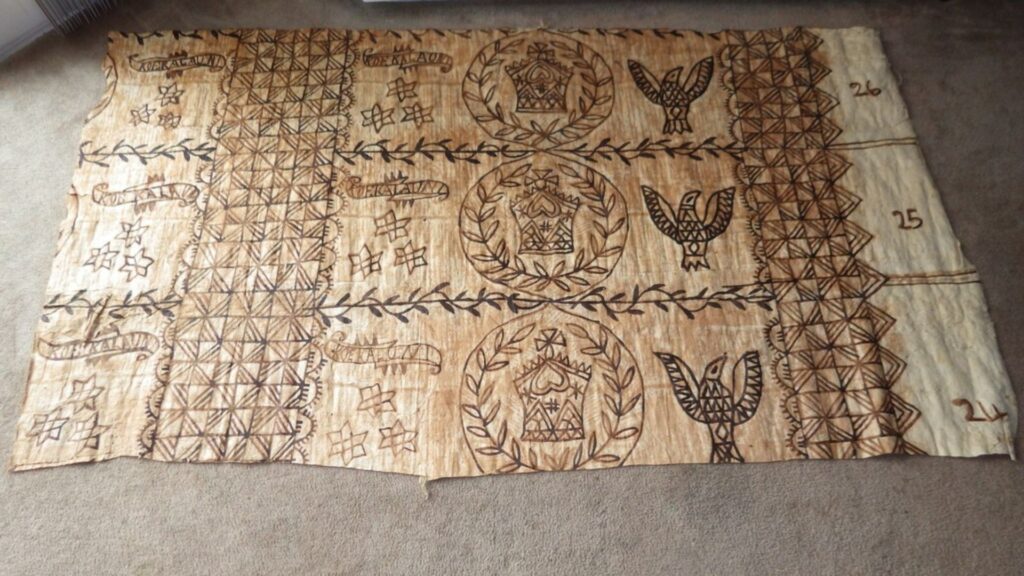
Cultural Role
- Ngatu is a prestige object: gifted at weddings, funerals, royal coronations, and community ceremonies.
- Rolls symbolize both wealth and blessing, carrying respect between families and across generations.
- Size and quality reflect status: the longer and more finely patterned the ngatu, the greater its cultural weight.
Living Heritage
Tonga remains one of the strongest centers of tapa-making in the Pacific. Today, ngatu continues to be produced and exchanged, embodying memory, identity, and cultural continuity.
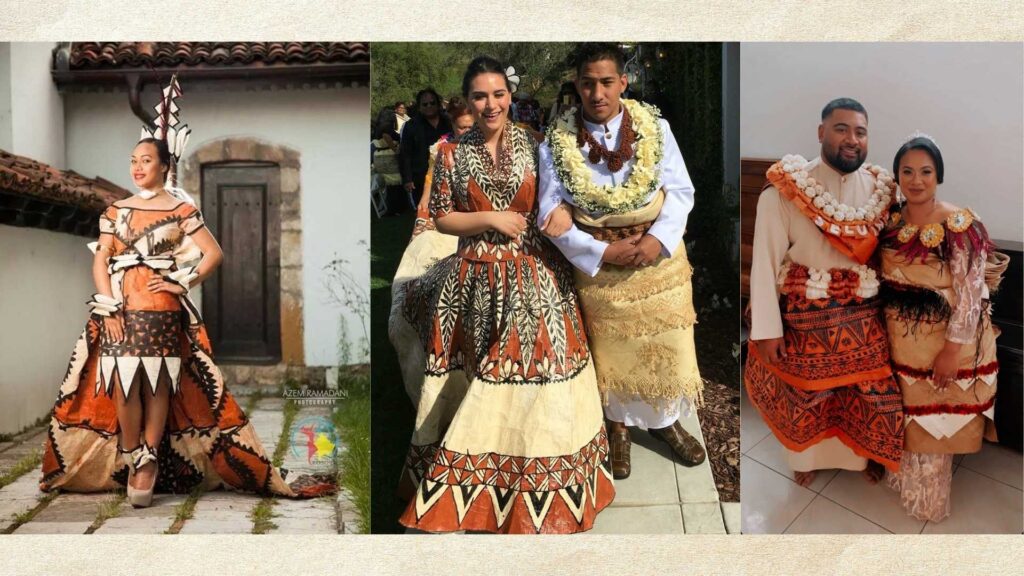
Samoan Barkcloth (Siapo)
Materials & Process
Siapo is made from the inner bark of the u‘a (paper mulberry in Samoan). Sheets are beaten thin, layered, and joined with arrowroot starch paste (masoā).
Decoration follows two main methods:
- Siapo mamanu: freehand painting with pandanus brushes (paogo).
- Siapo ‘elei / tasina: rubbing natural dye across a stencil board (‘upeti) woven from pandanus or carved wood.
Natural Dyes & Palette
Samoan artisans worked with a limited, earthy palette:
- o‘a (brown, background wash)
- lama (black, candlenut soot)
- loa (red, achiote)
- ago (yellow, turmeric)
- soa‘a (purple)
- ‘ele (reddish earth)
This restraint in color gave siapo its distinctive balance of boldness and harmony.

Patterns & Identity
- ‘Upeti framework: Siapo ‘elei often shows a grid of repeating rectangles or oblongs, giving the cloth a strong geometric rhythm unlike the long rolls of Tongan ngatu or the minimal stamped kapa of Hawai‘i.
- Mamanu freedom: In siapo mamanu, artists painted directly, filling space with fluid lines and motifs while still working within the natural palette.
- Motifs: Breadfruit leaves (fa‘a lau ‘ulu), banana pods (fa‘a tumoa), fishing nets (fa‘a ‘au‘upega), starfish (fa‘a ‘aveau), and shells (fa‘a ‘ali‘ao) – all echoing Samoa’s deep ties to land and sea.
Cultural Role
Siapo was worn, displayed, and gifted at major life events such as weddings, funerals, and community ceremonies.
Today, it survives in both traditional practice and as a form of wall art, helping sustain knowledge, pride, and local economies.
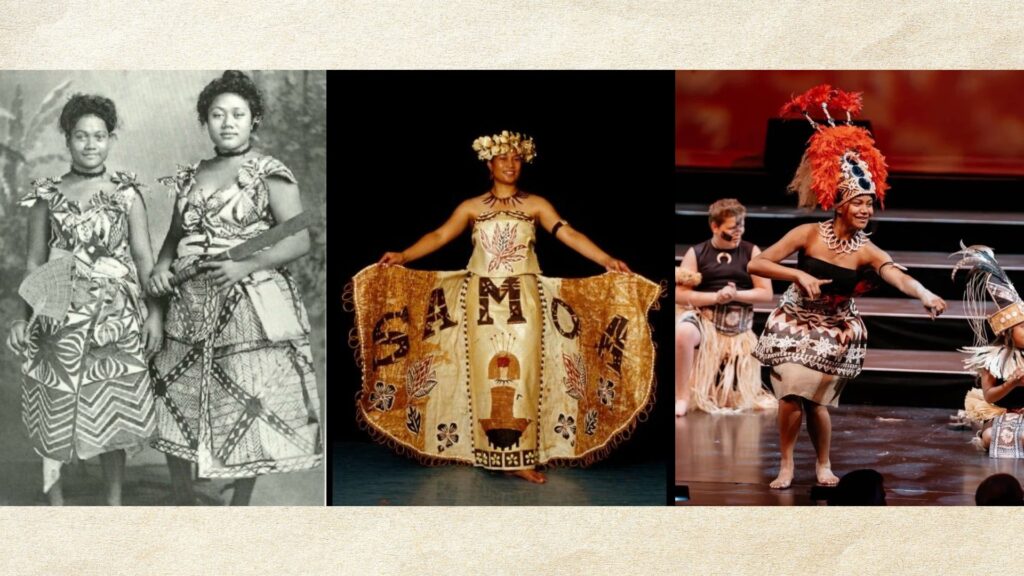
Fijian Barkcloth (Masi)
In Fiji, barkcloth is known as masi, a tradition deeply tied to both daily life and ceremonial culture.
Materials & Process
Fịian Masi is produced most regularly on Vatulele and Moce (Lau) Fji.
After beating and joining sheets, artists decorate using stencils such as wood/pandanus kupeti and leaf stencils (draudaru) by rubbing natural dyes across the templates.
Distinct types include masi kesa (stencilled), masi kuvui (smoked brown), seyavu (plain white), and masi vakarerega (yellow).
Natural Dyes
A restrained, earthy palette: brown washes (often from plant bark), black from candlenut soot mixed with plant juices, and smoked tones in masi kuvui.
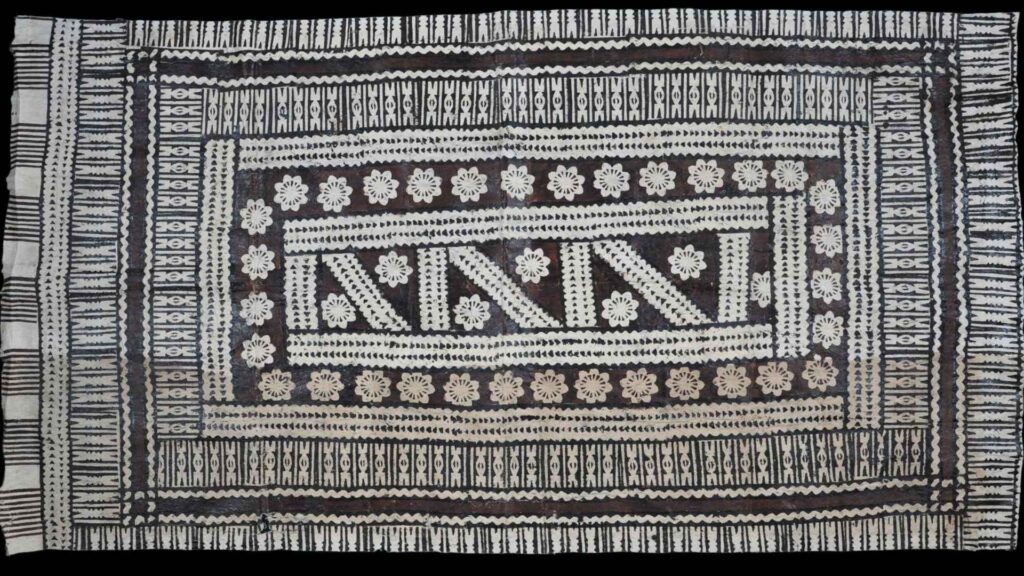
Patterns & Identity
- Masi kesa layout: Bold black–brown geometric motifs repeated from the border toward the centre, a hallmark that sets Fiji apart.
- Motif system: Repeating grids, chevrons, triangles, lozenges, and bordered fields created via kupeti/draudaru; composition is typically high-contrast on a cream ground.
- Some patterns are associated with particular regions or lineages and ceremonial contexts, but attributions vary by community and should not be asserted as universally “clan-specific” without local evidence.
- Typologies: Palette and finish can signal status, white or brown masi historically associated with chiefly rank; masi kuvui offers a distinctive smoked brown identity within Fiji’s repertoire.
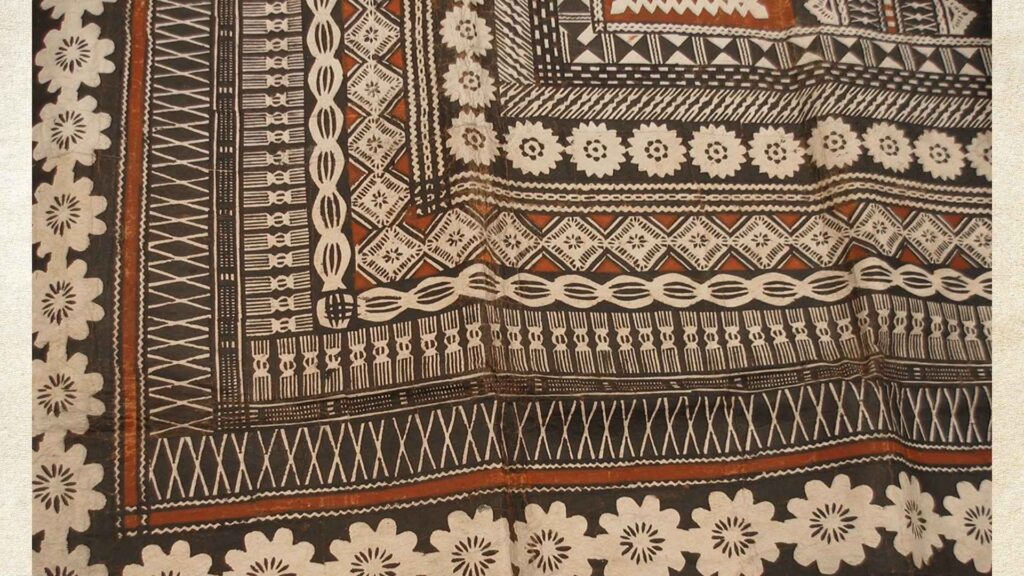
Cultural Role
Masi is central to weddings, funerals, and chiefly installations; large cloths are displayed and exchanged to forge or renew alliances.
Depending on region and occasion, brides and grooms may wear, drape, or be wrapped in masi. Colour signals rank: white or brown masi is traditionally used by those of chiefly blood.
Today
Masi remains vibrant in ceremonial life, performances, museum collections, and fashion, sustaining knowledge and livelihoods while showcasing Fiji’s distinctive visual language.
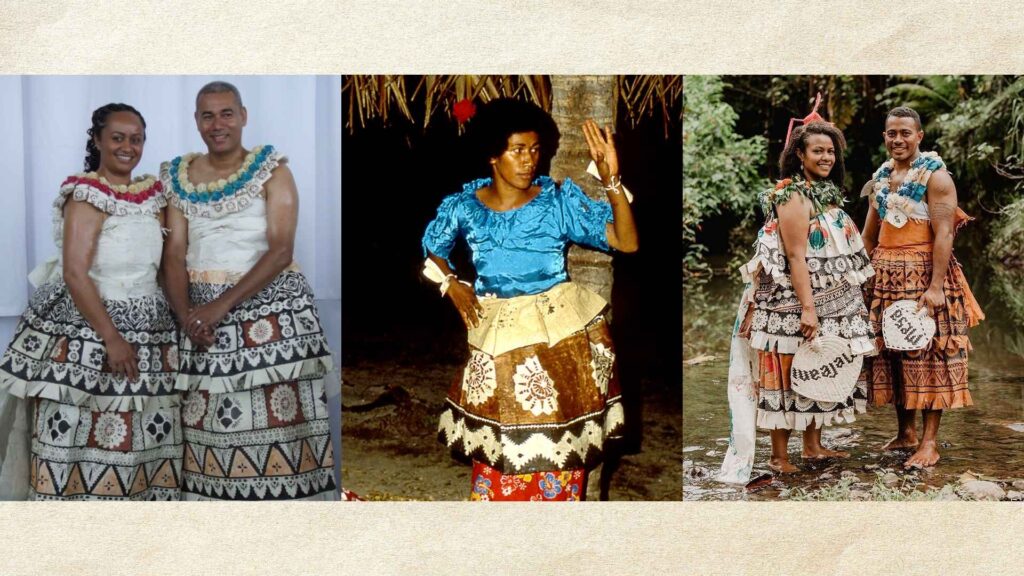
Barkcloth Shared Threads Across Islands
Across Hawaii, Tonga, Samoa, Fiji, and many more islands in Polynesia, Melanesia, barkcloth traditions highlight the same themes:
- Nature as source: All barkcloth begins with trees, roots, and natural dyes.
- Community as backbone: Making barkcloth was never solitary; it was social work, bonding women and families.
- Spirituality as meaning: Whether wrapping chiefs, idols, or brides, barkcloth always carried sacred weight.
- Identity as fabric: Designs tell who you are, where you came from, and what you believe in.
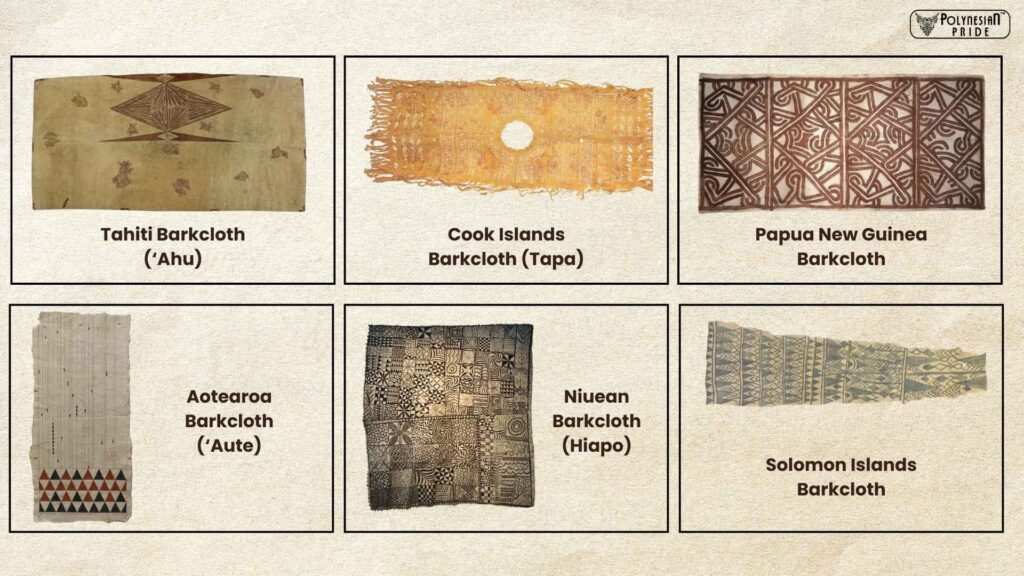
Barkcloth across the Pacific shows that while styles differ, the essence remains the same: it is fabric that weaves together land, spirit, and people.
Barkcloth in Modern Life
While barkcloth has ancient roots, its story continues in the modern world.
From mid-century home décor to today’s fashion runways and eco-design movements, barkcloth has adapted across time while preserving its cultural spirit.
Mid-Century Vintage Popularity
By the 1940s, barkcloth had found its way into Western homes, such as barkcloth drapes, curtains, and upholstery. Its heavy texture was perfect for barkcloth curtains and drapes, which hung neatly and resisted wrinkles.
At this time, barkcloth popular prints included tropical flowers, palm leaves, and even atomic-era geometric patterns. Collectors today love this mid-century barkcloth because it combines retro flair with durability. Owning vintage barkcloth curtains is like owning a piece of design history.
Influence in Contemporary Fashion
Modern designers look to barkcloth for inspiration. While few use traditional barkcloth directly, many mimic its textured feel in cotton or synthetic blends. Sustainable brands experiment with bark fibres mixed into eco-friendly fabrics.
On runways, tropical prints often echo the bold motifs of siapo or masi. This blending of heritage and fashion keeps barkcloth relevant in the 21st century.
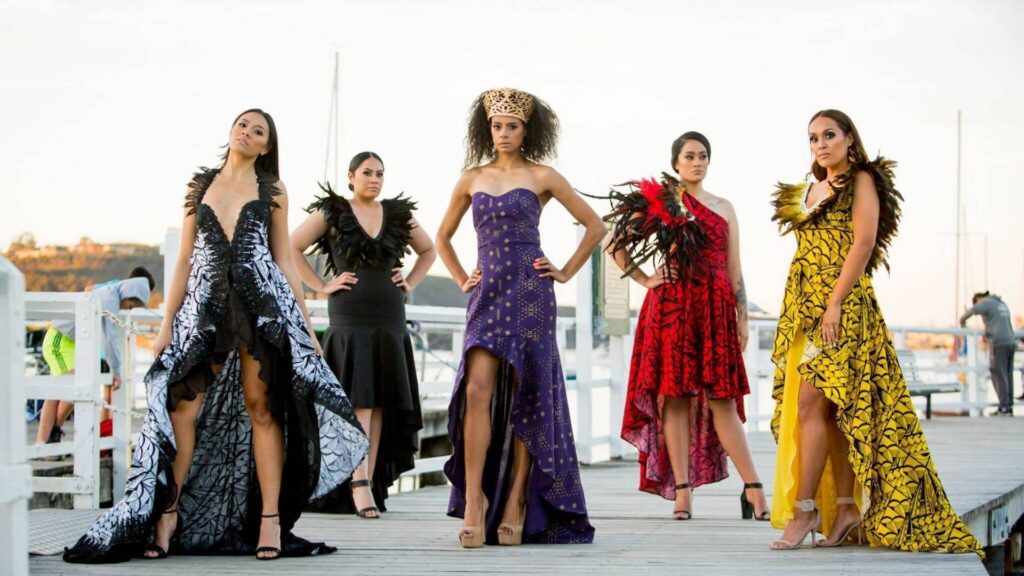
Revival of Cultural Practices
Barkcloth is also being revived as a living culture:
- Hawaii: Artists like Dalani Tanahy teach workshops on growing wauke and beating kapa.
- Tonga: Ngatu remains central to ceremonies, often produced in large rolls.
- Samoa: Siapo continues as both a cultural practice and a commercial art, sold as wall hangings.
These revivals prove barkcloth isn’t locked in the past—it adapts while keeping its roots alive.
Eco-Friendly Symbol
In today’s sustainability movement, barkcloth shines as an eco-material:
- Biodegradable and renewable.
- Made without industrial machinery.
- The entire lifecycle from tree to cloth that remains natural.
For eco-conscious consumers, barkcloth is more than heritage. It’s a model for sustainable design and proof that traditional methods can guide the future.
Barkcloth vs Modern Fabrics
Why choose barkcloth over cotton or synthetics?
| Pros: | Cons: |
| Unique texture and look. | Labour-intensive production. |
| Deep cultural meaning. | Not as soft or uniform as modern fabrics. |
| Durable and eco-friendly. | Rare and often more expensive. |
For many, the value isn’t just in practicality but in heritage. Owning barkcloth is like owning a piece of cultural art.
Final Thoughts on Barkcloth
So, what is barkcloth? It’s a scared bridge across islands and generations. From Hawaiian kapa to Tongan ngatu, Samoan siapo, and Fijian masi, barkcloth ties people to land, tradition, and spirituality.
Next time you see barkcloth curtains, vintage upholstery, or a ceremonial sheet at a wedding, remember: this isn’t just decoration. It’s the echo of hands beating bark into cloth, the rhythm of ancestors carried into today.
FAQs
1. What is barkcloth fabric used for?
It has been used for clothing, bedding, ceremonial wear, curtains, upholstery, and decorative arts.
2. Is barkcloth still made today?
Yes, Tonga, Samoa, Fiji, and Hawaii artisans continue making barkcloth for tradition and art.
3. Are barkcloth curtains durable?
Yes. Its thick texture makes it perfect for drapes, giving a vintage look and long life.
4. What is the difference between barkcloth and cotton?
Barkcloth is non-woven and made from tree bark fibres. Cotton is woven, softer, and more uniform.
5. What is Hawaiian barkcloth called?
It’s called kapa, a traditional fabric decorated with stamps and natural dyes.
6. Do Samoa, Tonga, and Fiji still make barkcloth?
Yes. Each island in Pasifika has its own version: siapo (Samoa), ngatu (Tonga), masi (Fiji) and each remains culturally important today.
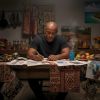
I’m a lifestyle curator who has blended Polynesian foodways and fashion into everyday life for over five years. I celebrate makers, materials, and style—with heritage as the headline, not the footnote.
My contact:
Email: [email protected]
Tel: +689 87 246 367

